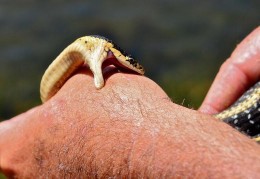What a Professional Herper Does

When you get a call, where do you start?
First, I try to provide some education that will make the homeowners more comfortable and aware of snakes. A lot of fear comes from what they don’t know. If there’s a nonvenomous snake in their yard, I’ll just go up and gently handle it, and they’re just like, “Whoa … that’s it?”
And if it’s venomous?
I use tongs, similar to a trash picker-upper, to grab them by the middle of their body and put them into a 15-gallon, locking tub.
Then what do you do with them?
I’m required to release these snakes within a couple of miles from the removal site, as close as possible. Sometimes you can’t do that because of proximity to other houses, but I always take it to the closest wildlife area. If the snake’s unhealthy, it’ll stick with me until it’s healthy. The state Department of Fish and Wildlife won’t give me permission to release it because one with a bite, or tick, or respiratory issue could infect other snakes.
Today in “uncommon jobs,” Orange Coast magazine has an interview with a professional herper (basically a person who charms and removes snakes from people’s properties) named Jason Magee. Magee says he charges a flat rate of $115 to inspect properties and remove both nonvenomous and venomous snakes.
Also: Some servicey advice about getting bit by a venomous snake: “Take off jewelry in case swelling occurs, keep the bite below your heart level if possible, and don’t move around. You don’t want to ice it, you don’t want to put stuff on it, you don’t want to try to suck out the venom — which can make it worse. Above all, seek medical attention immediately.”
Good thing I read this, because I would have definitely tried to suck that venom out.
Photo: Lina Tanner
Support The Billfold
The Billfold continues to exist thanks to support from our readers. Help us continue to do our work by making a monthly pledge on Patreon or a one-time-only contribution through PayPal.
Comments